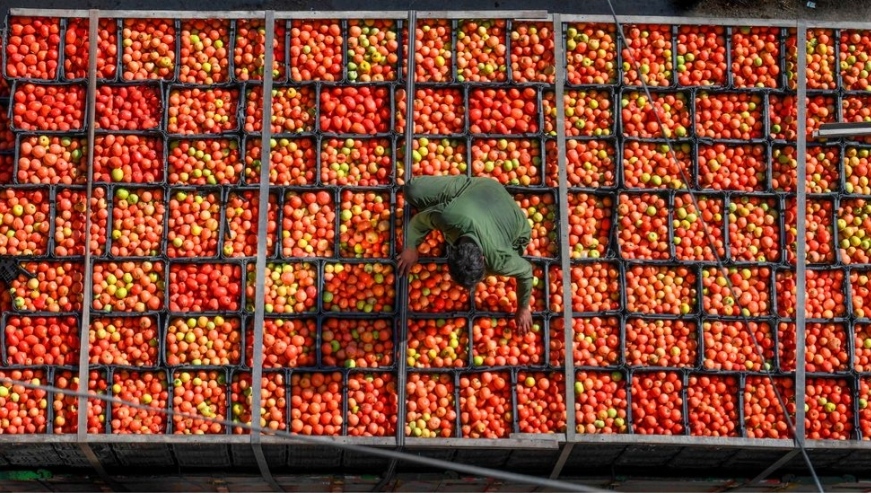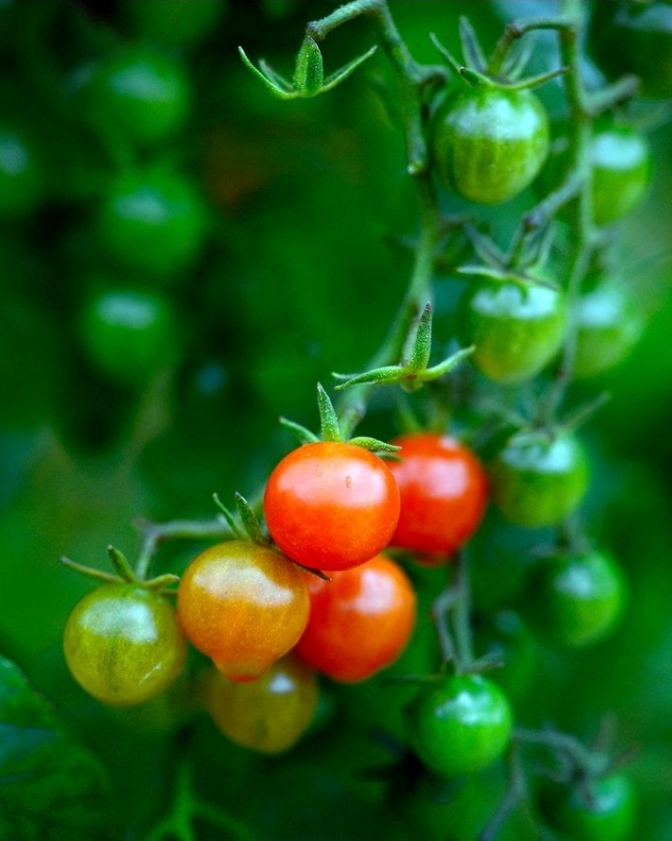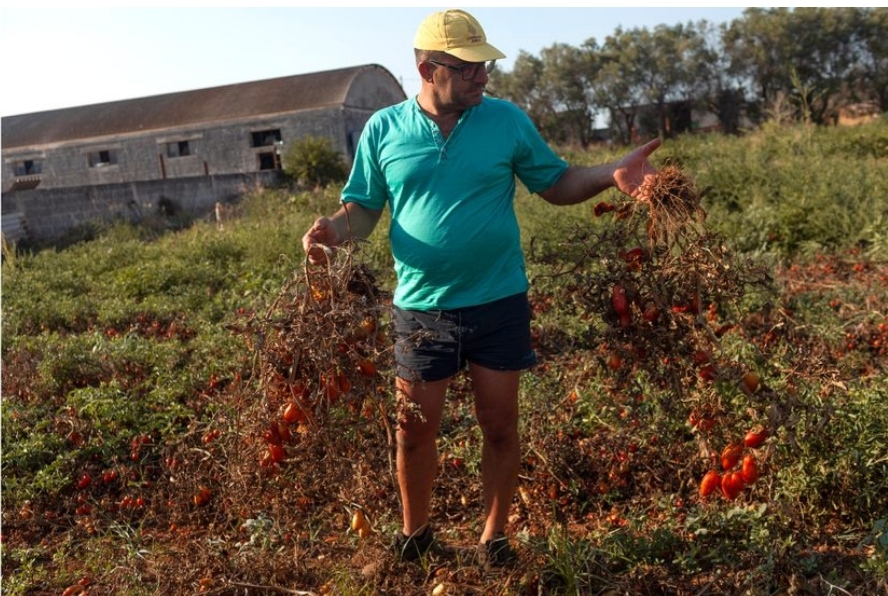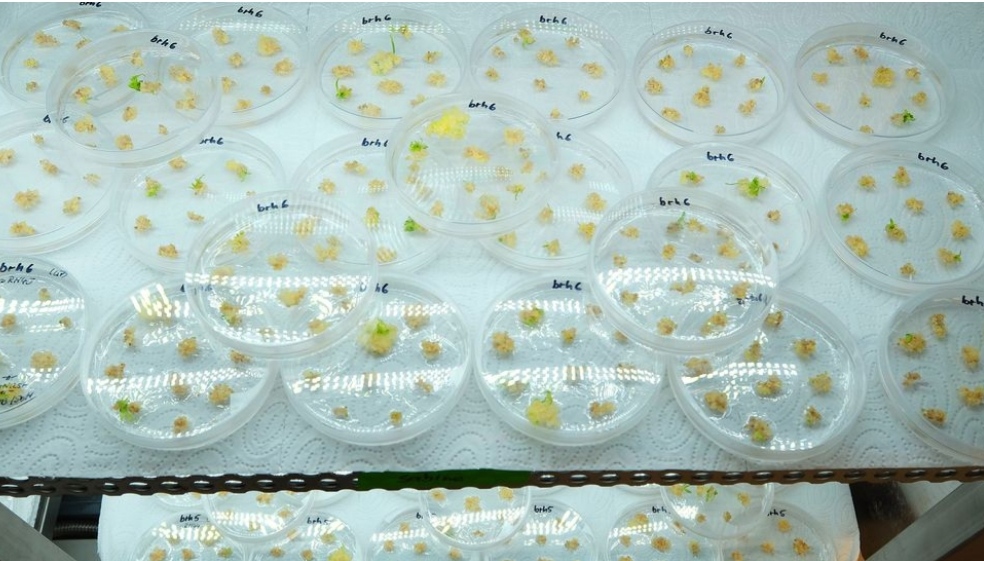The tomatoes at the forefront of a food revolution

By
Marta Zaraska
As global temperatures increase and extreme weather events become more common, can gene editing help to tweak our food plants so they can cope with the changes?
At first glance, it looked like any other plant that can be found growing in the corners of offices or on the windowsills of university laboratories. But this particular tomato plant, grown in 2018 at the University of Minnesota, was different. The bushy tangle of elongated leaves and small red fruits were characteristic of a wild species of tomato plant native to Peru and Ecuador called Solanum pimpinellifolium, also known as the red currant tomato. A closer inspection, however, made the plant’s uniqueness more apparent.
This particular plant was more compact, with fewer branches but more fruits than the wild tomato. Its fruits were also a little darker than was usual, a sign of increased lycopene – an antioxidant linked to a lower risk of cancer and heart disease. It had, in fact, been designed that way.
The plant was created by geneticist Tomas Cermak and his colleagues with the use of Crispr gene editing, a Nobel Prize-winning technology which works like a “cut and paste” tool for genetic material. The technique is now revolutionising agriculture and helping create crops for the future.
Cermak himself is on a mission to find a perfect tomato, one that would be easy to cultivate, nutritious and tasty, yet more adaptable to a changing climate. “The ideal plant would be resistant to all forms of stress — heat, cold, salt and drought, as well as to pests,” he says.
Climate change spells trouble for many crops, and tomatoes are no exception. Tomatoes don’t like heat, growing best between 18C (64F) and 25C (77F). Cross either side of that threshold and things start going downhill: pollen doesn’t form properly, the flowers don’t form into berries in the way they should. Once the mercury goes over 35C (95F), yields begin to collapse. A 2020 study showed that by mid-21st Century up to 66% of land in California historically used for growing tomatoes may no longer have temperatures appropriate for the crop. Other modelling studies suggest that by 2050 large swaths of land in Brazil, sub-Saharan Africa, India and Indonesia will also no longer have optimal climate for cultivation of tomatoes.

Solanum pimpinellifolium is a wild tomato found in Peru and Ecuador which bears fruit the size of currants
Of course, as average temperatures rise, other, previously too chilly regions, may become tomato-friendly. Yet observations in Italy show that weather extremes are something to consider, too. The 2019 growing season in northern Italy was marred by hail, strong winds, unusually high rainfall, and both exceptional frost and exceptional heat. The result was stressed tomato plants and poor harvests.
And there is more. Water scarcity, which forces farmers to use lower quality irrigation water, often containing salt, leads to increases in soil salinity – something commercial tomato cultivars don’t like. Higher ozone levels, meanwhile, make tomatoes more susceptible to diseases such as bacterial leaf spot.
That’s all troubling, especially considering that tomatoes are currently the largest horticultural crop in the world – humanity produces 182 million tons of the fruit every year, equivalent to the weight of almost 32 Great Pyramids of Giza. What’s more, our appetites for tomatoes are growing fast – over the last 15 years global production of tomatoes rose by more than 30%.
Besides being humanity’s favourite fruit, tomatoes also happen to be a model crop: they are fast to grow, easy to breed and relatively simple to manipulate on a genetic level. “There is more funding available for research than there is for other plant species to develop resources like genome sequences, genetic engineering, and gene editing for tomato,” says Joyce Van Eck, plant geneticist at Cornell University in New York. Taken together, this makes tomatoes perfect for study of novel gene editing technologies such as Crispr, which could bring us many climate-adaptive crops in the near future.
Once the climate-smart genes such as these are identified, they can be targeted using Crispr to delete certain unwanted genes, to tune others or insert new ones
Crispr is a molecular toolbox scientists have repurposed from bacteria – when bacteria are attacked by viruses, they capture and cut the viral DNA to prevent the aggressor from being able to replicate and so fight it off. In use in plants since 2013, Crispr now allows researchers to modify genome with extreme precision and accuracy to obtain traits they desire. You can insert genes, delete them, and create targeted mutations. In non-human animals Crispr is being used for the study of human disease models, for improving livestock, and could even potentially be used to resurrecting extinct species. In plants, it can help create better, tastier, more nutritious and more resistant crops.
The first step is finding the right genes to target. “We need to identify the genes responsible or involved in being able to withstand abiotic and biotic stress because otherwise we cannot alter, modify or knock them out by using gene editing,” says Richard Visser, plant geneticist at Wageningen University, the Netherlands.
Domesticating crops, tomatoes included, has led to a huge loss of genetic diversity. Modern commercial cultivars may be fast to grow and easy to harvest, but genetically speaking they are plain vanilla. Just four highly homogenised crops – soybeans, rice, wheat and corn – dominate global agriculture, accounting for more than half of all the world’s agricultural land.
In contrast, their wild cousins – as well as so-called landraces (traditional varieties adapted to specific locations) – are a treasure box of genetic diversity. This is why scientists now search this genetic pool to identify traits that can be reintroduced into commercial plants – a process much helped by fast-dropping costs of DNA-sequencing technologies.

As climate change alters rainfall patterns, new varieties of drought resistant crops will be needed in areas that struggle with water shortages
One 2021 study looked at the genome of Solanum sitiens – a wild tomato species which grows in the extremely harsh environment of the Atacama Desert in Chile, and can be found at altitudes as high as 3,300m (10,826ft). The study identified several genes related to drought-resistance in Solanum sitiens, including one aptly named YUCCA7 (yucca are draught-resistant shrubs and trees popular as houseplants).
They are far from the only genes that could be used to give the humble tomato a boost. In 2020 Chinese and American scientists performed a genome-wide association study of 369 tomato cultivars, breeding lines and landraces, and pinpointed a gene called SlHAK20 as crucial for salt tolerance.
Once the climate-smart genes such as these are identified, they can be targeted using Crispr to delete certain unwanted genes, to tune others or insert new ones. This has recently been done with salt tolerance, resistance to various tomato pathogens, and even to create dwarf plants which could withstand strong winds (another side effect of climate change). However, scientists such as Cermak go even further and start at the roots – they are using Crispr to domesticate wild plant species from scratch, “de novo” in science speak. Not only can they achieve in a single generation what previously took thousands of years, but also with a much greater precision.
De novo domestication of Solanum pimpinellifolium was how Cermak and his colleagues at the University of Minnesota arrived at their 2018 plant. They targeted five genes in the wild species to obtain a tomato that would be still resistant to various stresses, yet more adapted to modern commercial farming – more compact for easier mechanical harvesting, for example. The new plant also had larger fruits than the wild original.
“The size and weight was about double,” Cermak says. Yet this still wasn’t the ideal tomato he strives to obtain – for that more work needs to be done. “By adding additional genes, we could make the fruit even bigger and more abundant, increase the amount of sugar to improve taste, and the concentration of antioxidants, vitamin C and other nutrients,” he says. And, of course, resistance to various forms of stress, from heat and pests to draught and salinity.

Some scientists believe that Crispr’s ability to accurately edit the traits of plants could usher in a new green revolution
De novo domestication could also make orphan crops more attractive. These are plants that are grown on a limited scale, but have a great potential to help food security. Groundcherry, a wild cousin of tomatoes which produces subtly sweet berries, is one such crop that has been recently domesticated with Crispr technology. In the near future, de novo domestication could bring crops as cowpea, sorghum and teff — all cereals native to Africa – to a far wider audience around the world. Crispr is also now being used to improve various other plants, from bananas and grapes to rice and cucumbers.
Some scientists believe that Crispr gene-editing marks the beginning of the second green revolution to help feed the fast-growing human population. Yet although the technology does hold a great promise for crop improvement, it’s “not a miracle potion”, Visser says. There are still technical hurdles to address.
“Efficiency of editing can be a problem in some crop species,” Van Eck says. As opposed to diploid plants like tomato (which have paired chromosomes), those that have more than two paired sets of chromosomes (known as polyploid, like wheat), are much harder to work on. “You basically have more copies of a gene in polyploids that need to be affected by Crispr than in a diploid,” Van Eck adds.

Scientists Emmanuelle Charpentier and Jennifer Doudna won the Nobel Prize in Chemistry for their discovery of the Crispr-Cas9 genetic scissors
Regulation and social acceptance are also an issue. Crispr modified plants can be “transgene-free” – meaning that unlike traditional genetically modified (GM) crops, those created by Crispr technology do not contain DNA from a different species (ie transgenic) – that’s because the technology either involves simply deleting genes, or may involve inserting genes from a different varieties of the same species (as is being done with tomatoes).
Yet, the few existing studies on acceptance of Crispr-edited food products show a mixed picture. In a cross-country survey conducted in USA, Canada, Belgium, France and Australia, people perceived Crispr-edited and GM food similarly. However, in a 2020 Canadian study, consumers were more willing to accept Crispr-edited foods.
And then, there is the law. Although in 2016 Crispr-edited mushrooms fell into a legal loophole in the US and escaped regulation, Europe’s highest court decided in 2018 that gene-edited crops should be subject to the same stringent regulations that govern conventional GM organisms.
For Cermak’s climate-smart “ideal tomato”, such legal hurdles paired with consumer hesitance, could prove a major obstacle.
Source : BBC Travel



